Frequently Asked Questions
What is Satori Japanese Plaster made out of?
Answer: Satori Japanese Plaster recreates the plastered walls used in Japanese homes, temples and teahouses for centuries, but is engineered for the modern living environment. The Elements and Universe series consists of natural earth particles and the Harmony series also contains diatomaceous earth. All are combined with modern pigment and bonding technology. The earth material used in our products has been carefully selected for quality and particle size consistency from around the globe. They are collected from areas in strict accordance with all regulations from land beneath the clay layer.
How is Satori different from Venetian plaster?
Answer: Venetian plaster is a lime-based finish often burnished to create the illusion of European old-world marble, travertine, or limestone. Satori Japanese Plasters are a natural earth sand and/or diatomaceous earth-based plaster originating in Japan with a distinctly Eastern look and feel. All Satori Japanese Plaster can be highly customized to create a range of colors, pigments and textures not attainable with wall paint, venetian plaster, wall tile or clay plaster.
What makes Satori better than traditional wall paint?
Answer: Satori Japanese Plasters are a great alternative to paint, wallpaper and other wall coatings. Unlike paint, our plasters are very versatile and can be texturized with additives to accommodate any style, from traditional to urban and contemporary.
What surfaces can Satori Japanese Plaster be applied on?
Answer: Satori Japanese Plasters are perfect for residential design, home improvement and commercial spaces. Please download the Substrate Preparation Manuals for each series to understand which wall surfaces are appropriate and how they need to be prepared in order to accept Satori plaster.
How do I keep Satori Japanese Plaster clean?
Answer: Satori plasters are not washable or “scrubbable”, but can be cleaned by dusting, patched or repaired. We offer the Satori Lifestyle Finish in the U.S. market for those wanting a stain resistant surface which can be cleaned with a mild soap and water. We still do not recommend the plasters be applied in areas which will be repeatedly exposed to water and other heavy staining areas such as showers, sinks and directly over a stove for instance.
Are Satori wall and ceiling plasters easy to apply?
Answer: Satori Japanese Plasters are relatively easy to apply by hand trowel. We recommend homeowners use an experienced plasterer familiar with applying fine interior plasters and finishes.
What about covering up “orange peel” or other textured wall surfaces?
Answer: The Substrate Preparation Manuals explain how to prepare textured surfaces and orange peel walls prior to applying Satori Japanese Plaster. Please consult a professional applicator before beginning such a project.
Does it qualify for LEED points as a Green product?
Answer: All Satori Japanese Plasters are certified SCS indoor Advantage Gold for low VOC (Volatile Organic Compounds). Low VOC products help to improve indoor air quality. The products are also a natural fire retardant. All Satori Japanese Plaster qualifies for 1 LEED point for IE Q Credit 4.2: Low-Emitting Materials—Paints and Coatings.
Do I have to use Japanese trowels?
Answer: No. But we do recommend Japanese trowels, as their flexibility and thinness work best with Satori interior plasters and makes them easier to apply. We offer a set of fine Japanese trowels for this purpose.
Does Satori Japanese Plaster work with Stencils?
Answer: Yes, Satori Japanese Plaster can be used with stencils if you do not exceed the recommended thickness for the products. Please consult the application manuals for each product. We have included some samples below made by Victoria Larsen using her stencils.
Raised Plaster:
Freestyle Bamboo Stencil
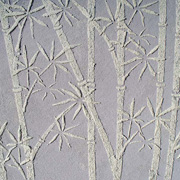
KRM S009 background with the design done in Silver KBB 54 with silver silky fibers.
Raised Plaster:
Tree Branch Stencil
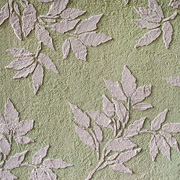
Background in SAO 41 and stenciling done with KRM 256.
Raised Plaster:
Carletta Frieze Stencil
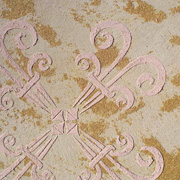
Background is KRM 256 blended with KBB Bronze 15 Stenciling done with KRM 104 mixed with gold silky fibers.
Raised Plaster:
Formosa Palm Stencil
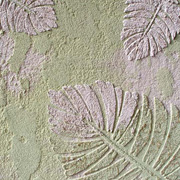
Background in KRM 256 and SAO 41 blended together. The same products used for the stencil with gold silky fibers added.
Raised Plaster:
Fern Leaves Stencil
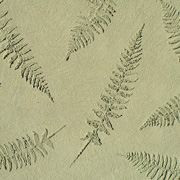
KRM 283 background and stenciling but green glass beads added to stenciling only.
Raised Plaster:
Swirls Texture Stencil
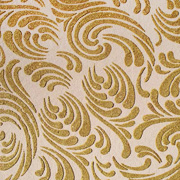
KRM 104 as the background Stencil design done in KBB Bronze 15 with bronze glitter.
Raised Plaster:
Oriental Dogwood Stencil
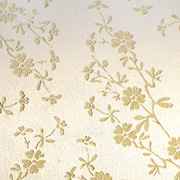
Background done with KRM 150 Stenciling done with KBB Gold 14 with gold glitter added.
Raised Plaster:
Asher Stone Stencil
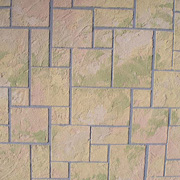
KRM S009 background to serve as the grout lines Swirls of the following colors over the stencil make the stones: KRM 150, 256, 283. These are blotted randomly on then smoothed together to blend.
Raised Plaster:
Chantilly Floral Stencil
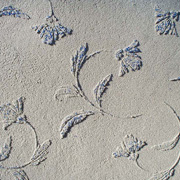
KBB 54 silver as the background. Same product used for the stenciling but added blue glass beads.
Raised Plaster:
Astana Medallion Stencil
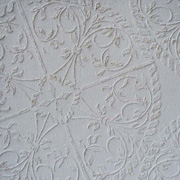
KRM 256 for both the back- ground and the stenciling but added gold silky fibers to the stencil.
To order Stencils, get Decorating Ideas and Learn to Apply Instructions, please visit victorialarsen.com.
To search for Stencil Applicators in your area, please visit the Hire a Pro section on Victoria’s website.
Victoria specifically works with plaster and is an excellent source for stencils and may be able to make recommendations for stencil plasterers in your area.
For answers about the specific preparation, mixing and application of Satori Japanese Wall Finishes, please refer to the Material Safety Data Sheets, Substrate Preparation Manuals and Application Manuals found on individual product pages of the website.
Satori Japanese Wall Finishes are low VOC interior plaster finishes which combine traditional Japanese design with modern luxury. Design or renovate any residential or commercial space with beautiful Japanese plaster finish walls and ceilings in a range of colors and textures.
Satori finishes are easy to apply and suitable for contractors, architects and designers as well as anyone passionate about home improvement familiar with plastering. Composed of natural earth sand and diatomaceous earth, they are a great alternative to paint, wallpaper or coatings. Certified SCS Indoor Advantage Gold; applicable towards LEED green building credits.


